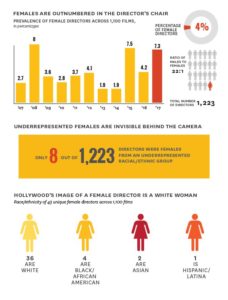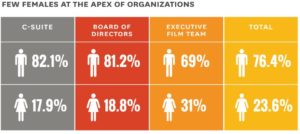The newest study from the Annenberg Inclusion Initiative reveals that there has been no change for Women, Black, and Asian film directors in over a decade.

Dr. Stacy L. Smith and the Annenberg Inclusion Initiative are pleased to share our newest report: . The report is the most comprehensive intersectional analysis of directors of motion pictures to date, combining data on the gender, race, and age of 1,223 filmmakers working on 1,100 top-grossing films released between 2007 and 2017. The analysis also focuses on women in executive and leadership ranks at major media companies.
The results reveal that for female, Black and Asian directors, there has been no meaningful change in over a decade and the doors to Hollywood remain mostly closed.
Some key findings on gender from the study include:
- Across 11 years and 1,100 movies, 96% of all directors were male and 4% were female. This translates to 22 male directors hired to every 1 female director.
- Only 4 Black female directors, two Asian female directors, and 1 Latina were hired to direct across 1,100 popular movies.
- Male directors start their careers earlier (20s) than female directors and some continue working into their 70s and 80s. The latter is not the case for women directors.
- The “one and done” phenomenon is far more likely for females than males. Most directors only worked one time across the 11-year sample, but pronounced gender differences emerged. 55% of the male directors only helmed one film whereas 84% of the female directors did.

Additional results focused on Black and Asian directors:
- In total, 5.2% of all directors were Black or African American. This represents no meaningful change over the 11 years studied.
- Only 3.2% of all directors were Asian. Across the 11-year sample, there has been no meaningful change over time.
- 81% of the films with a Black director also had a Black actor attached as one of the two top-billed talent. This finding suggests that the vast majority of directing opportunities for Black directors are linked to the race of the story’s leading characters.

In this edition of the report, we also examined the executives and Boards of seven major media companies. A few notable findings include:
- A full 82.1% of prestigious C-suite jobs were held by males and only 17.9% by females. Among these women, only 4 were from underrepresented racial/ethnic groups.
- Focusing on Boards of Directors, 18.8% of seats were filled by women and only 3 of these females were underrepresented.
- Among the executive film teams, only 2 of the chairs (25%) across the major media companies evaluated were women.
- Females filled almost a quarter (23.9%) of the President and Chief positions on executive film teams and roughly 41.2% of all EVPs, SVPs, and VPs. While the latter findings are encouraging, few women are holding the keys to the most powerful executive positions in Hollywood.

The study also examines film distribution by company:
- Across the 11-year sample, a total of 997 (90.6%) of the 1,100 movies were distributed by 7 major media companies.
- Of those 997 films, the company with the highest number of female directed movies was Warner Bros. Pictures (12 movies) and the lowest were Paramount (3 movies) and Lionsgate (3 movies).
- Films with Black directors were most likely to be distributed by Lionsgate, where 15 of the 18 movies were helmed by Tyler Perry.
- Walt Disney Studios has not attached a Black director to any of their top-grossing films in the sample.
- Universal Pictures was the most likely to distribute a movie with an Asian director (13 films) and Lionsgate was the least likely (1 film).
Make sure to read the full Annenberg report, available . Visit the AFIC WDA Facebook to find out more here!


